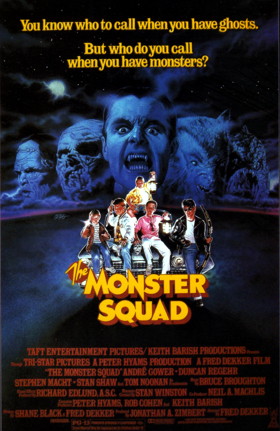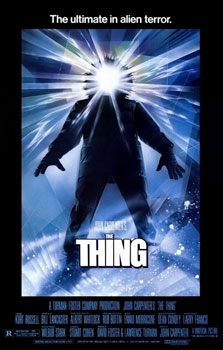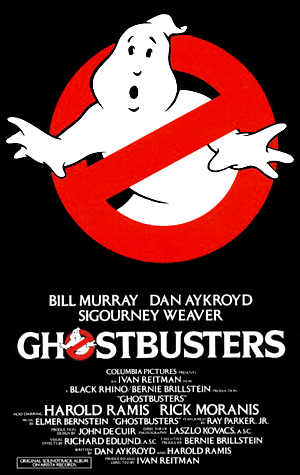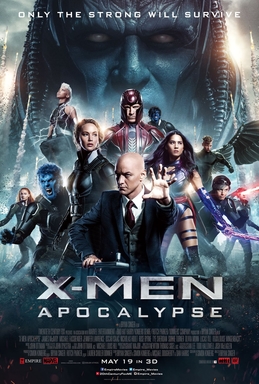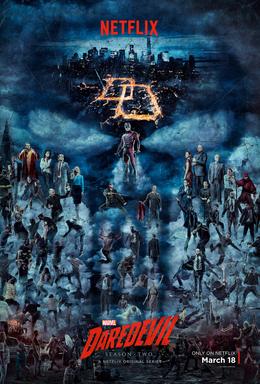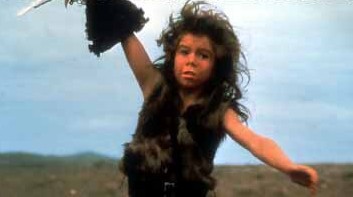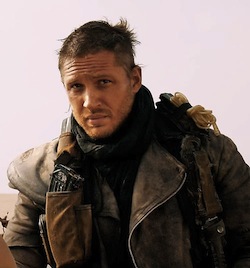Perspectives
Some ideas just get stuck in your head. Some concepts are repeated so often they become inescapable. The world is a scary place when fact is only what confirms our biases. Whatever happened to just having a good ol’ opinion? Why do we, as a society, feel the collective need to shove our beliefs down the communal throat?
Whether it’s been obvious or not, there has always been an allegorical component to Retrobacktive. I am not yearning for Doc Brown to arrive in a time-traveling DeLorean to take me back to 1985 and am merely passing the time chronicling childhood memories. Examinations of the past ought to influence our blueprints for the future, if in no other way than forcing us to reevaluate our malleable recollections.
Below is an opinion – and just an opinion – that tends to contradict a generally accepted standard. It’s a little mental ventilation; over the years I’ve given cultural milestones a lot of thought. They’re the kind of things that most people either never object to or just don’t consider, but the flaws – again, to me – are so glaring they warrant some statement or record of dissent. Most are movies. Hey, it’s Retrobacktive; what did you expect? But the purpose of these articles is always to rethink, reexamine, and ideally reapply some thought. So let’s start with this:
Terminator 2: Judgement Day is not better than The Terminator
Typically the first film in any series is regarded as “the best.” It stands to reason someone came along, did something original, and captured audiences off guard. Everyone remembers getting caught up in something unexpected and it imbues an emotional element that lingers, in some cases for a lifetime.
But occasionally a sequel outperforms its predecessor (we’ll get to more of those shortly). The Terminator film series is one of the most indelible in sci-fi/fantasy. It transcends cinema and has become a cultural institution. And most people familiar with these films regard the second one, T2: Judgement Day, as the best.
They’re wrong; I’m right, and here’s why…
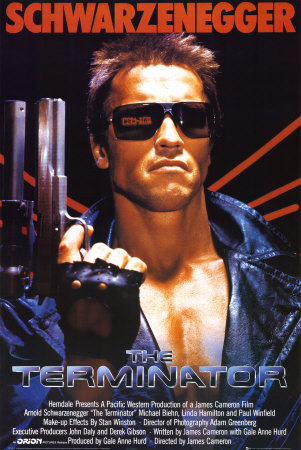
Arnold Schwarzenegger in The Terminator
Let’s start by dismissing everything that came after T2. In this case the audience is right: the following three sequels are significantly inferior. The first two Terminator films, both directed by James Cameron, are gems, so that’s where we’ll focus.
When The Terminator came out in 1984 it was a sleeper hit. No one expected it to be a smash. Cameron had only recently come out from under the wing of famed schlock filmmaker Roger Corman. He was relatively untested and only had experience with low-budget projects. Likewise Arnold Schwarzenegger, who only recently found limited fame with the Conan movies, was still up-and-coming, his star-power nowhere near the echelon it would reach in a few short years. Linda Hamilton and Michael Biehn were almost totally unknown.
The premise was out there. Sci-fi was still consider low-brow cinema, and here was a film about a time-traveling robot roaming the streets of L.A. and indiscriminately killing people. See? Sounds schlocky.
The Terminator, however, had several unexpected things working for it, namely great actors, the perfect role for a former bodybuilder, and a genius writing duo in Cameron and Gale Anne Hurd.
The script Cameron and Hurd turned out is pure sci-fi gold, which is to say it’s fairly simple. A sentient computer sends an infiltration unit (aka The Terminator) back through time to kill the mother of its enemy. The computer’s enemy is able to send back a lone protector to guard his mother and ensure his survival, a battle ensues.
It’s a simple premise because it fits squarely into one of the four traditional story archtypes:
Man vs. Man
Man vs. Society
Man vs. Monster
Man vs. Machine
And since it’s 2018 I hear they are working on a fifth: Woman vs. Patriarchal Society That Thinks Every Story is About a Man (I got you covered, ladies).
Nonetheless, despite the time travel and killer cyborg, the movie is written and framed in a manner that does not force the audience to extend its disbelief all that far. That is the hallmark of any great story – how far do you have to extend your disbelief? Sure, we all love the occasional cartoon (take The Avengers; it’s a fun movie, but it’s a cartoon), but most adult audiences don’t want their intelligence insulted when they go to the movies.
So if you buy into the story, you’ll find Cameron and Hurd leave few details unexplained. The grimy streets of L.A. are a perfect backdrop for the Terminator’s cold, emotionless presence. The tone is dark, the pace is consistently suspenseful; Hamilton and Biehn portray excellent story arcs. Oh, and Stan Winston’s effects are out of this world – the actual Terminator endoskeleton looks like something that could actually exist. The movie triumphs on just about every level, and rightfully so became a phenomenon.
In today’s cinematic landscape, Carolco, the film’s production company, would have cranked out a sequel in couple years. But Cameron moved on to other projects – notably Aliens (which we’ll get to) and The Abyss. Schwarzenegger cemented his career with a string of high-profile action films including the classics Predator and Total Recall. Moviegoers had to wait seven years for a follow-up Terminator film, but when they did it, they did it right.
Cameron and William Wisher (who added dialogue to the original film) teamed up again to write the screenplay, while most of the cast and crew from the first movie came back (save Biehn who only appears in one deleted scene). The story picks up about 12 years after the events of The Terminator with the differences being a new, more advanced cyborg sent back in time to target Sarah Connor’s adolescent son directly and Schwarzenegger’s Terminator – a different model than the antagonist in the original – is rewired and sent back to protect him.
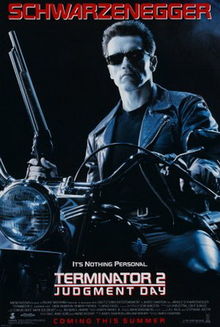
Don’t get me wrong; the movie is excellent. The dialogue is great, the characters are intriguing, Linda Hamilton owns Sarah Connor’s stunning transition from passive victim to stone cold ass-kicker, and the visual effects were revolutionary for the time – honestly they still stand up today.
The real highlight of T2 though is the action. It’s an adrenaline rush. There’s bar fights, car chases, prison breaks, helicopter crashes, and too many explosions to count. It’s a lot of fun, but…
It’s a fine line between excitement and imagination. While the former spoon feeds you entertainment, the latter makes you work for it. Sometimes mood will dictate which you prefer, but usually one attribute speaks more loudly than the other for each individual. So here’s were T2 flounders:
1) It isn’t as well grounded. This starts with the T-1000, the new Terminator sent to kill John Connor. It’s an advanced prototype composed of liquid metal. It can replicate the form of humans and disguise itself in virtually any situation, its hands and arms can be molded into stabbing weapons, and it can regenerate from almost any form of attack. The concept is…interesting, but it’s a little out there. What is “liquid metal?” We never get a detailed explanation as to how the T-1000 works. It’s almost more alien than machine and this begins the trend of forcing the audience into a far removed, fantasy world.
2) Continuity errors aplenty! This is big pet-peeve of mine; I hate when writers and directors dismiss the audience’s capability to store and retain details. All the action and excitement of T2 tend to cover this up, but here’s a short list starting with the present-day timeline.
- The events of the first film take place in 1984. Sarah Connor is pregnant with John at the end of the film. So let’s assume it was early 1984 during conception and John was born at the end of the year (I believe there is a reference to this in the beginning of T2 when the T-1000 looks up John’s police record). In T2 John is 12 years old, so that would put the setting of the second film somewhere around 1996. The Terminator explains in this timeline the events that lead to Judgement Day take place on August 23, 1997. He prefaces this by detailing the development of the Skynet Defensive System (the software that becomes self-aware and starts Judgement Day) by Miles Bennet Dyson which happens “in a few years.”
See the problem here? The movie is supposed to take place during the time of its release, 1991. But John would only be seven in this timeline. Go ahead and try to slice it anyway you want, it doesn’t line up. More disbelief.
- The film also backtracks on well-conceived plot points from the original film. Michael Biehn’s character states the reason for targeting Sarah and not John was Skynet had to wipe out his very existence since the program’s mainframe was destroyed moments before the original Terminator was sent back through time. By sending back a cyborg to kill John himself it essentially nullifies the whole first movie.
- Then there’s Dr. Silberman. This is a smaller detail but one that always got me. In the first film he evaluates Sarah after being rescued by police from what is – at the time – believed to be a deranged Kyle Reese (Michael Biehn). In the second film he works as the chief psychiatrist of the mental hospital Sarah’s been committed to. Unlikely coincidences aside what irks me most is how dismissive he is of Sarah’s “delusions” despite the fact that he literally left the police station in the first film moments before the original Terminator went on a rampage in it and killed 17 police officers! You have to assume he became intimately aware of the situation the next day given his proximity. So you think he’d be a little more sympathetic towards a woman he knows was involved in no less than two traumatic events.
I know it’s a small thing, but how hard would it have been to create a new doctor character for the second movie? I get for the sake of momentum it’s easier to throw continuity out the window, but when you are that close to perfection why not go the extra mile?
When you’re writing an article critiquing one of the greatest sequels ever made – one of the greatest sci-fi movies every made – the refrain has to be this is still a great movie. Although it’s not perfect, T2 is one of those movies I can pretty much stop and watch no matter what I’m doing. But if you asked me to pick between the two, I’ll always go with The Terminator. And for one simple reason: style. The Terminator is a sci-fi/horror flick; T2 is sci-fi action. The former is much darker and cerebral compared to the bombastic tone of the latter. It’s the kind of film that has to be read between the lines to elicit maximum enjoyment. Such movies are becoming exceedingly rare. Given the popularity of The Terminator franchise, having two classics to compare side-by-side helps demonstrate the success one could find creating a simple premise with a thoughtful execution… so long as one concurs that The Terminator is the best!
Epilogue:
Touching base on the aforementioned examples of classic films and their (arguably) superior/inferior sequels – it’s topic for another article, one encompassing an entire list. But since James Cameron was a focal point of discussion here it’s worth following up on the Aliens reference.
This is an another classic film series that parallels the Terminator canon in a lot of ways. The first two films are masterpieces, different in tone and style, but both brilliant. A few others followed, but they were much weaker entries. James Cameron directed the second film in 1986; Ridley Scott made the original, Alien, in 1979.
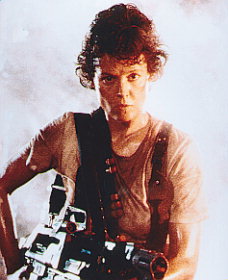
Sigourney Weaver in Aliens
Similar to The Terminator, the first movie is much darker, much scarier, and far more graphic. Aliens is more about the action. Unlike The Terminator, however, I have a far harder time picking which Alien movie I like more. They’re both phenomenal but so strikingly different that it’s almost like comparing apples and oranges. One thing for certain is Aliens is a sequel that does not disappoint. If this one has flown below your radar, do yourself a favor and watch it.

